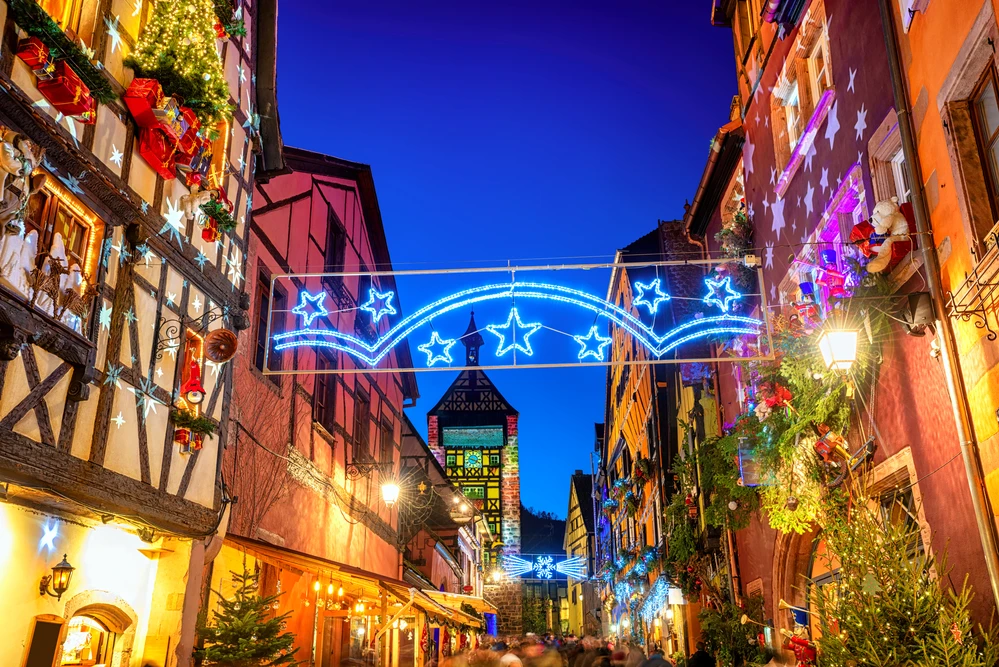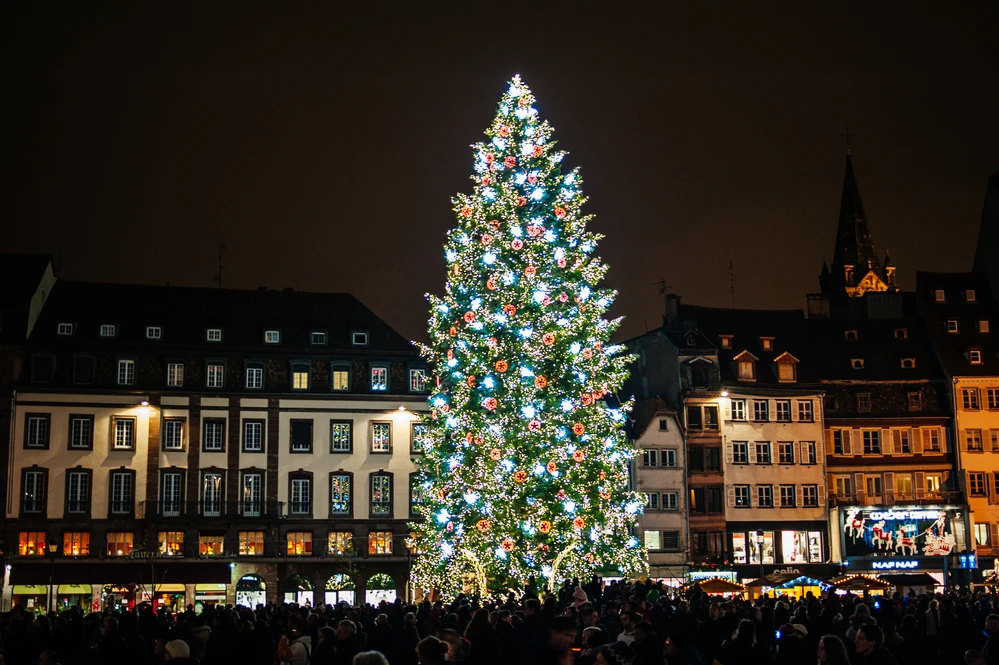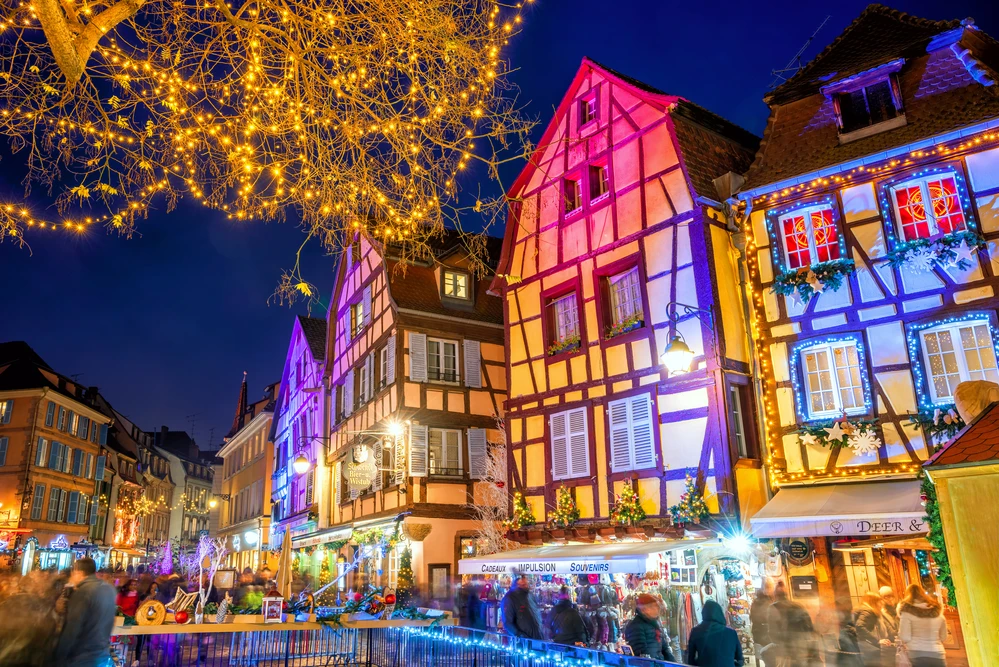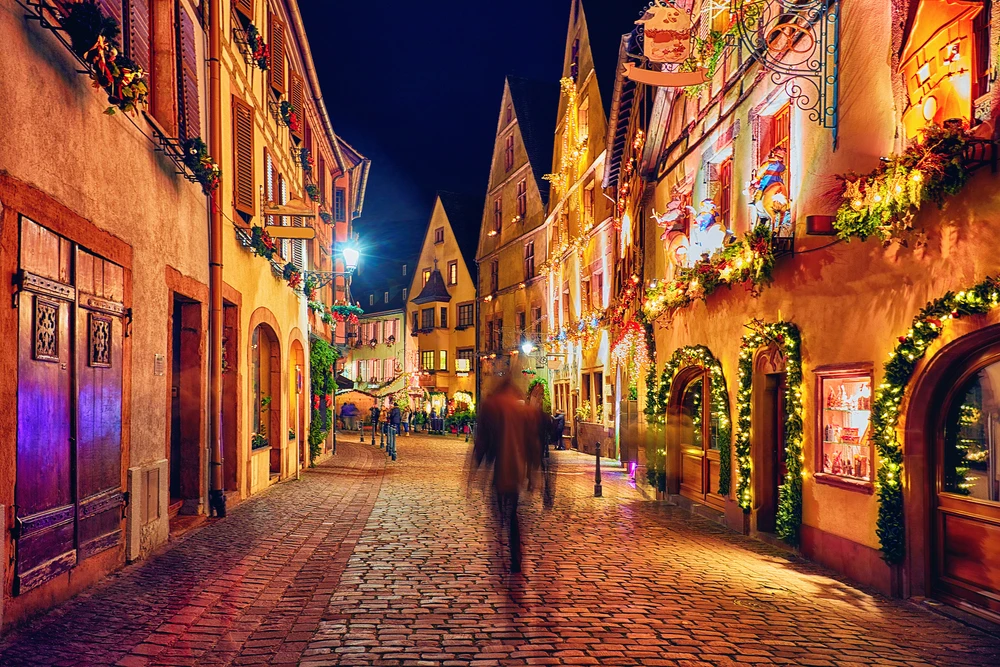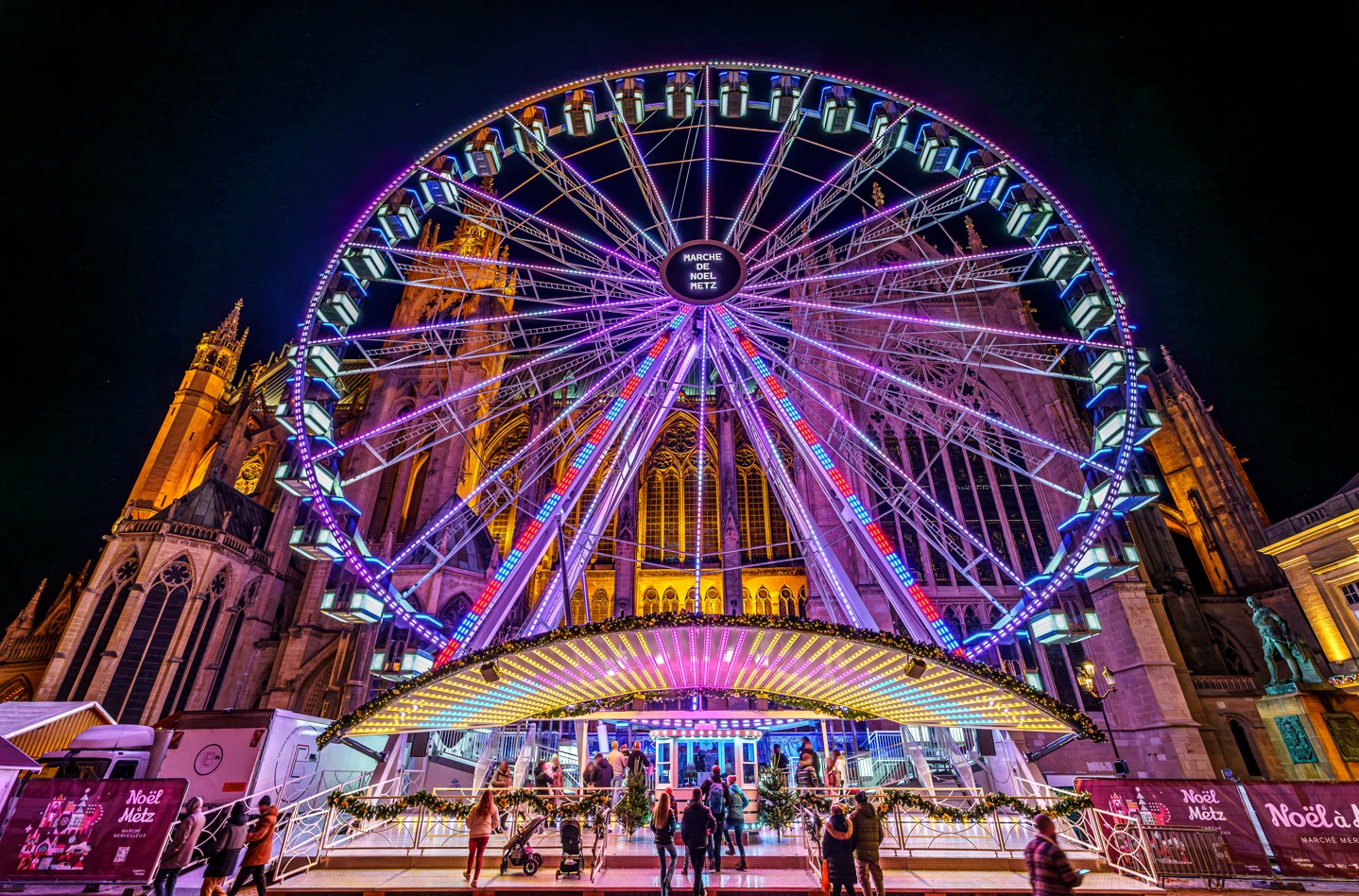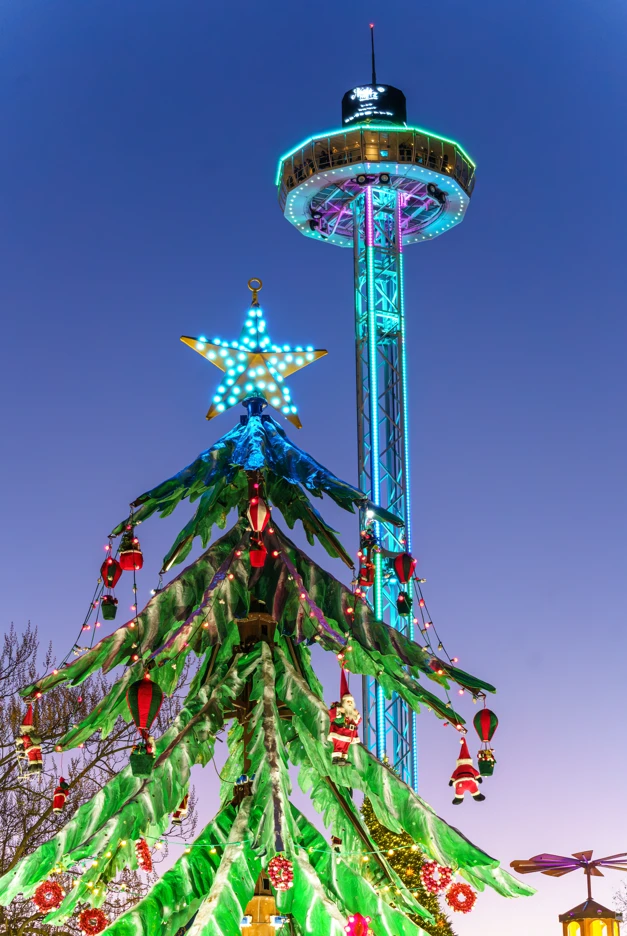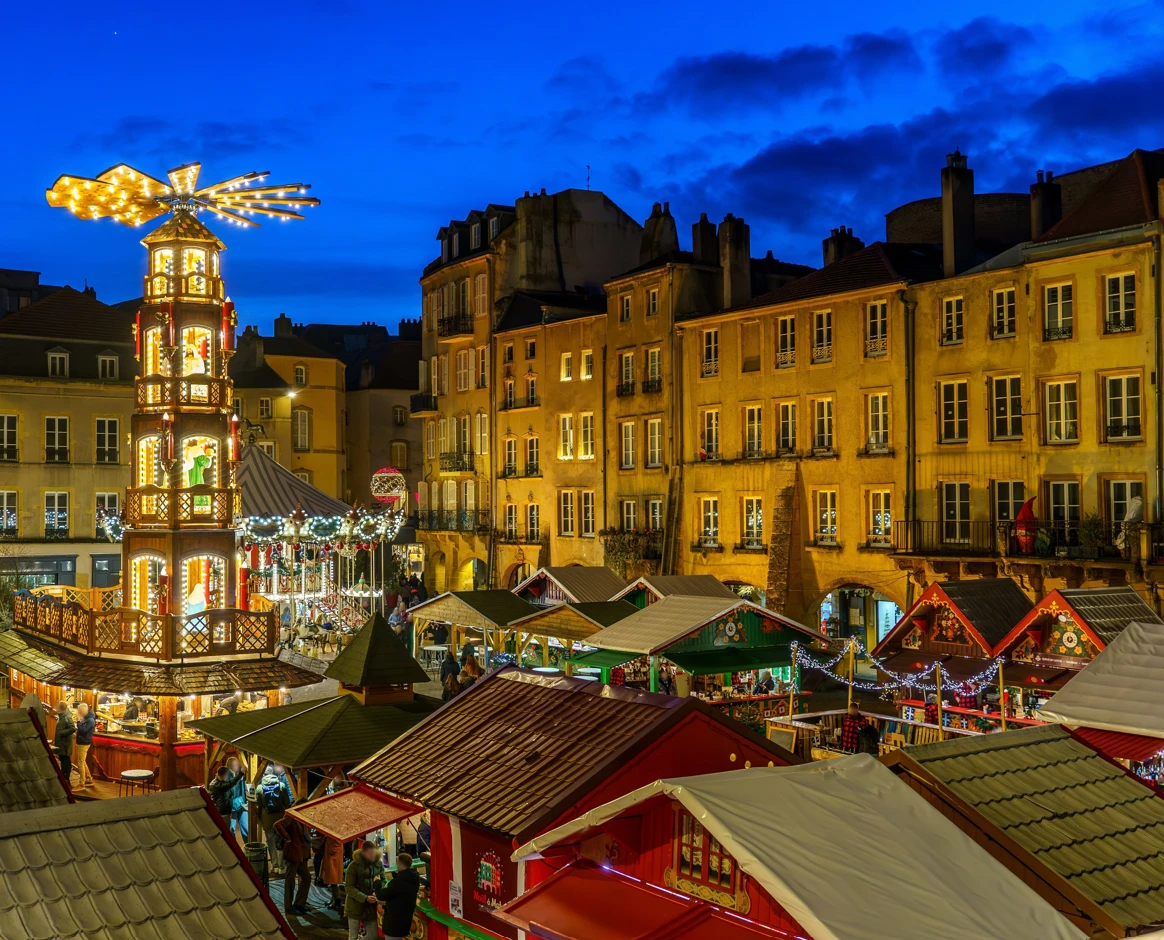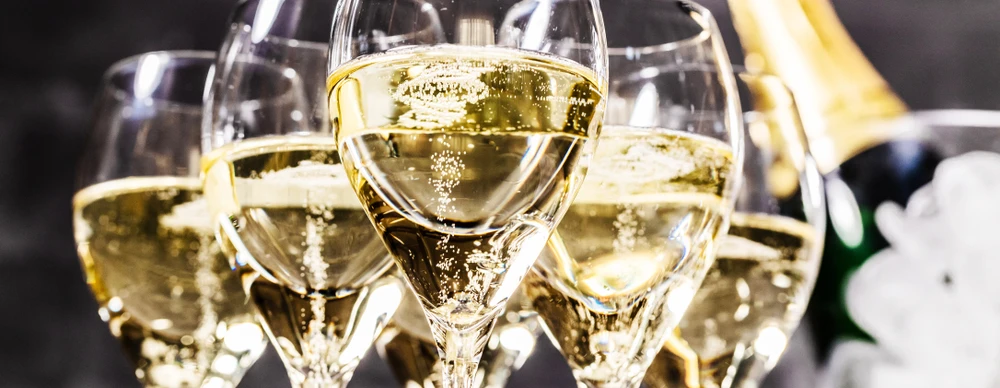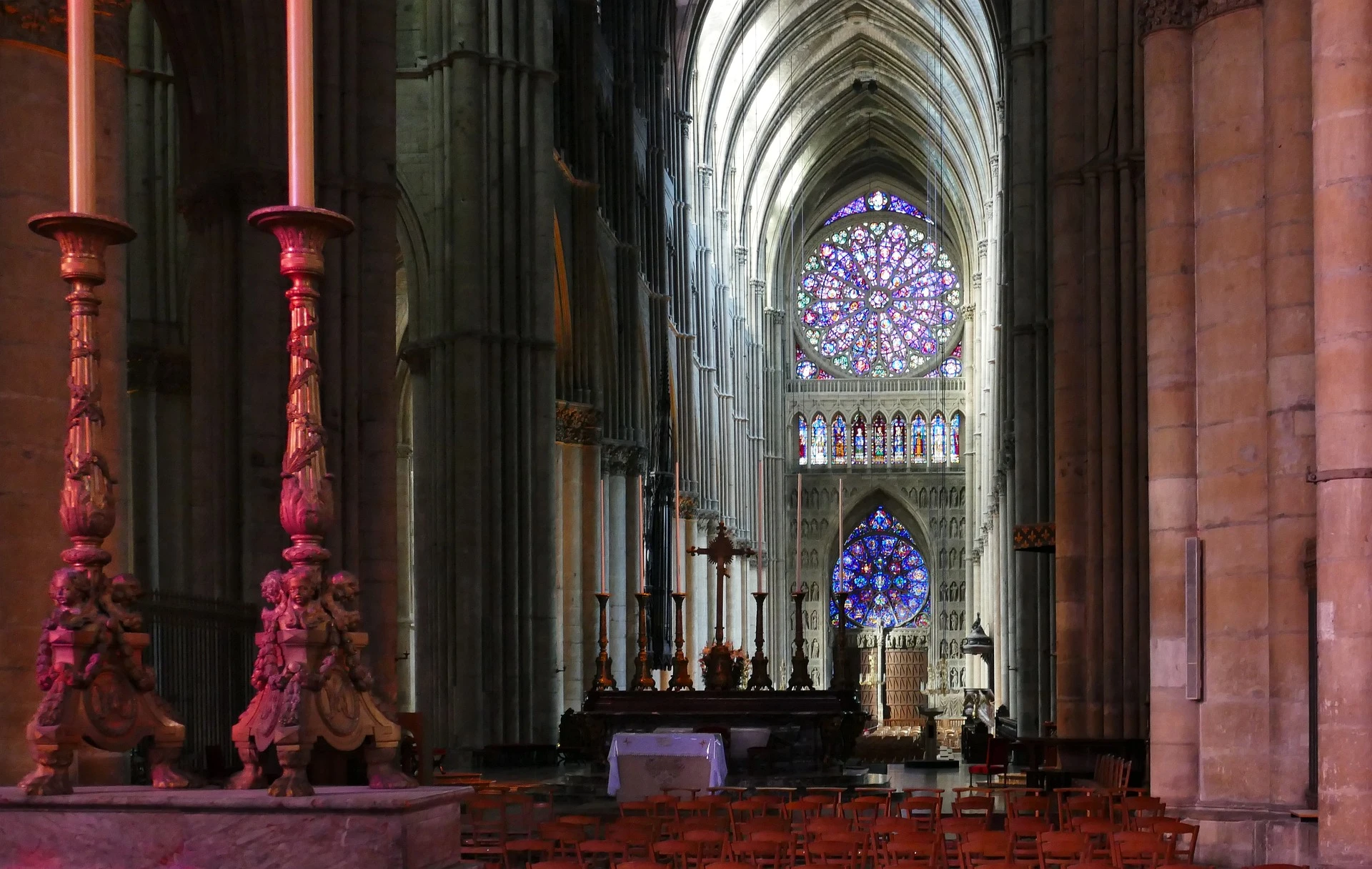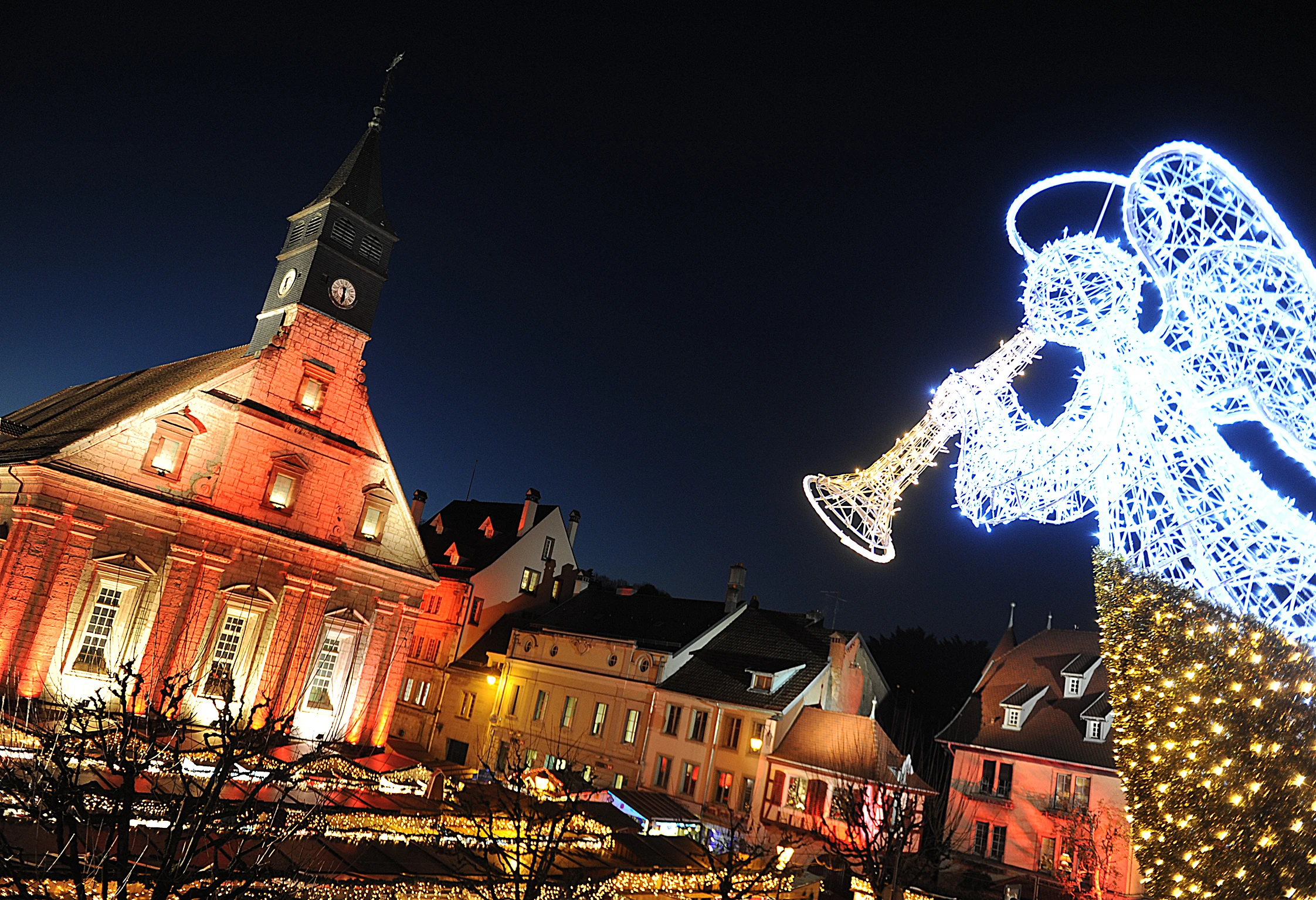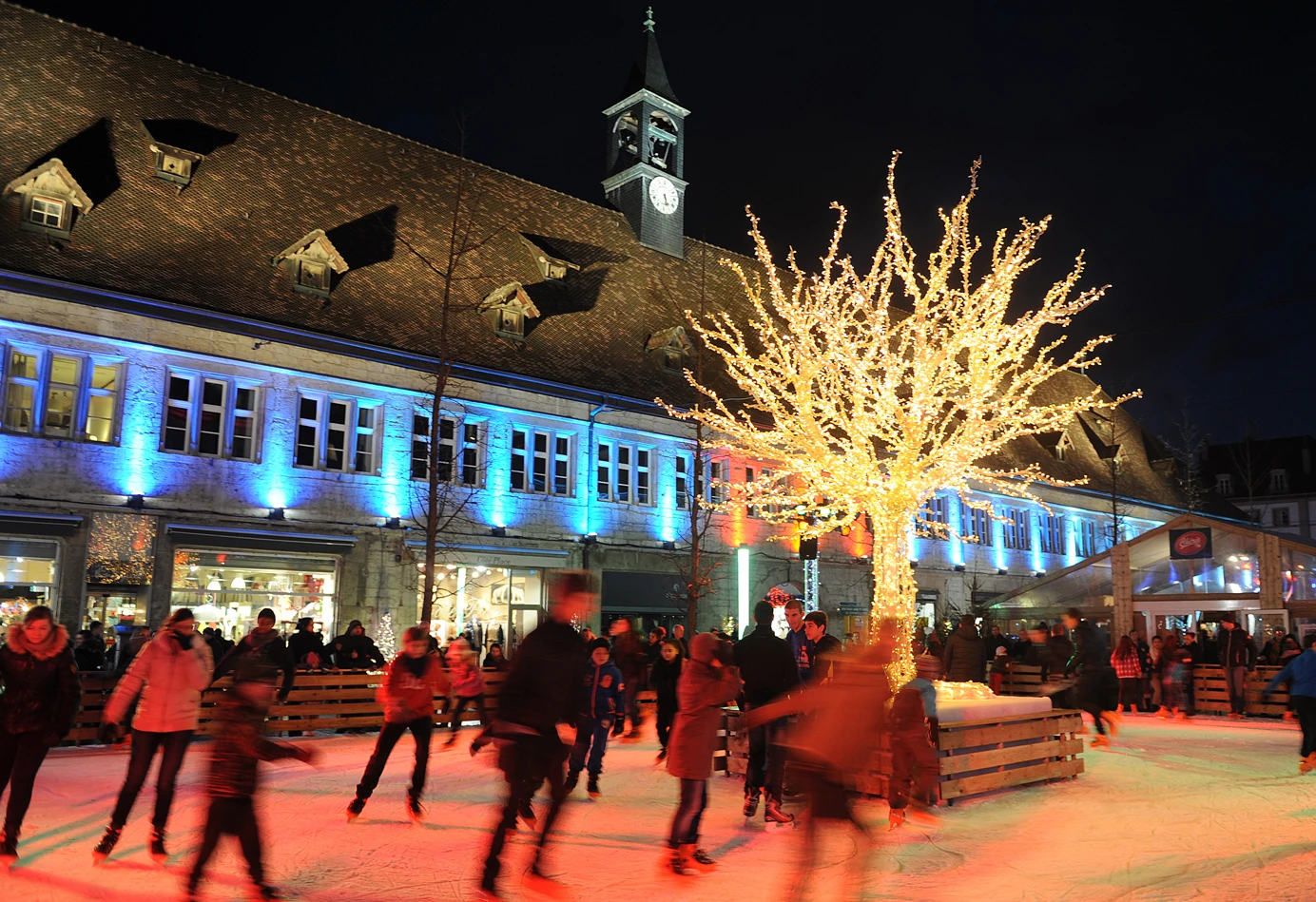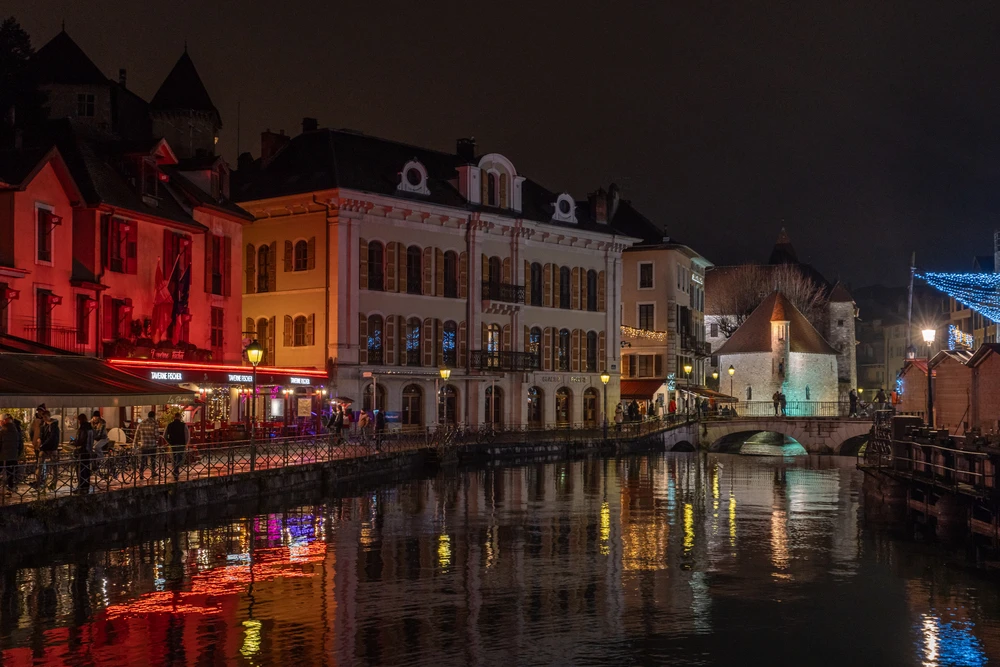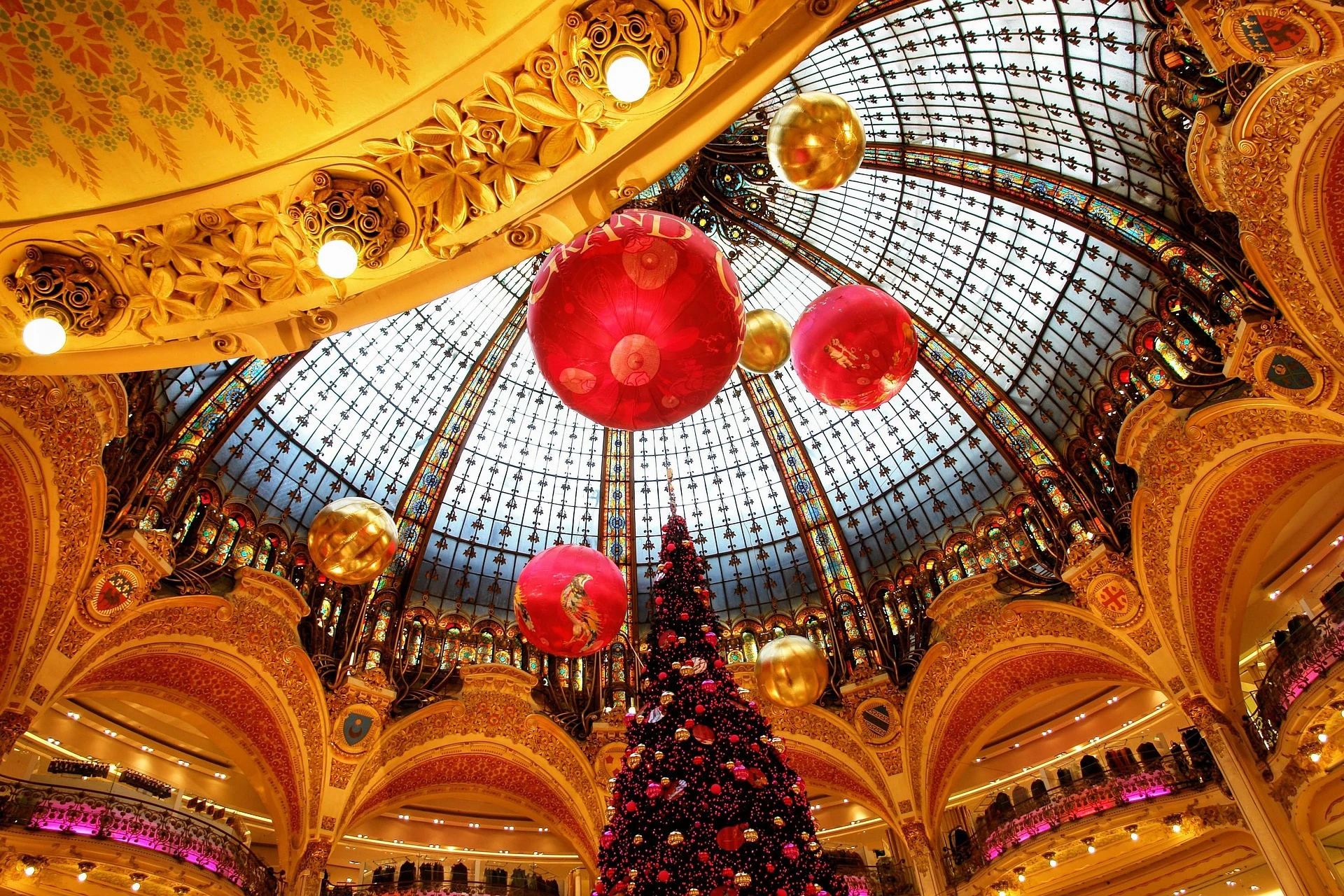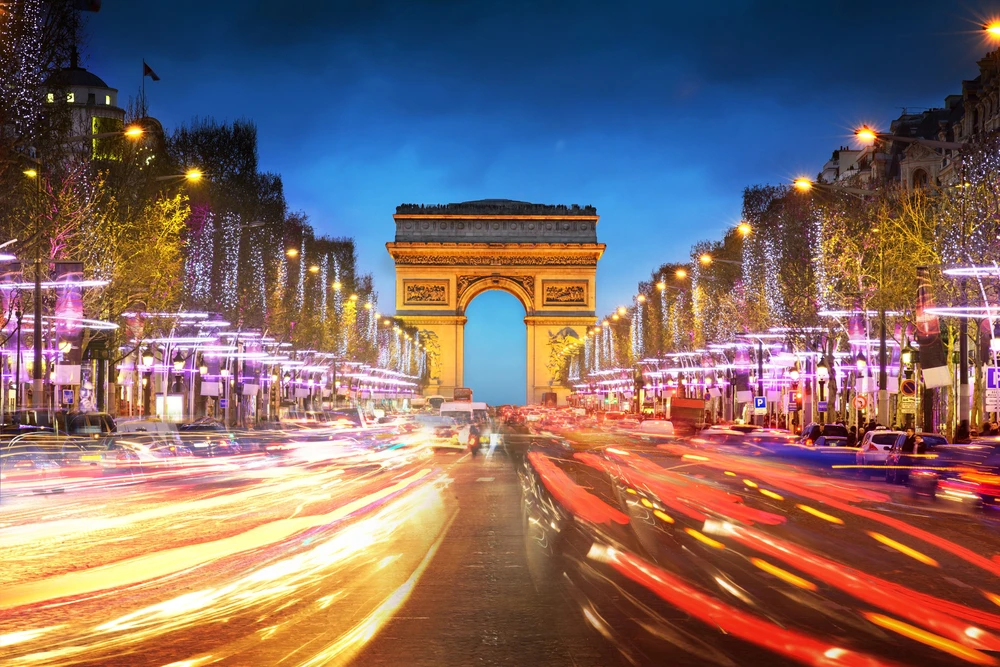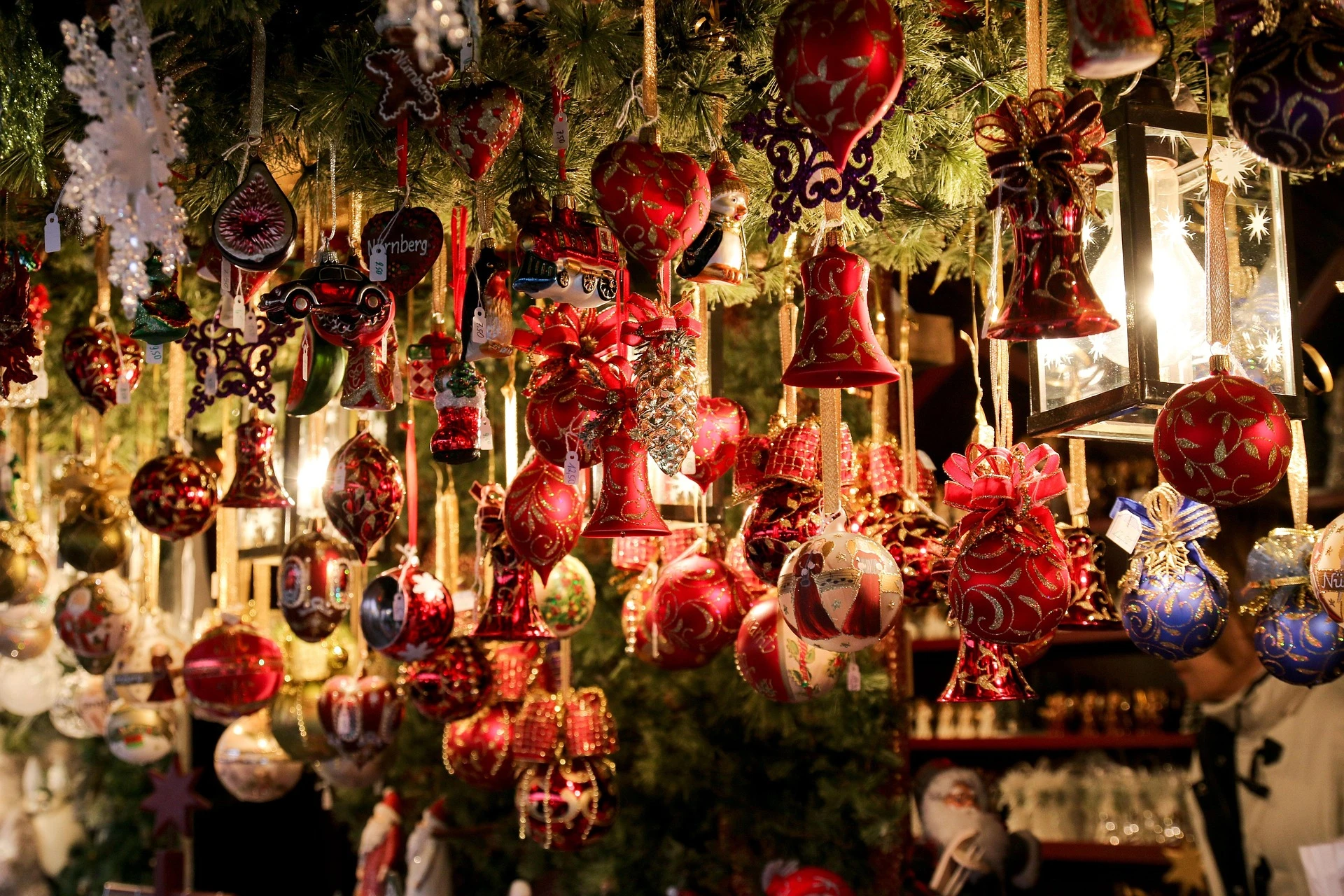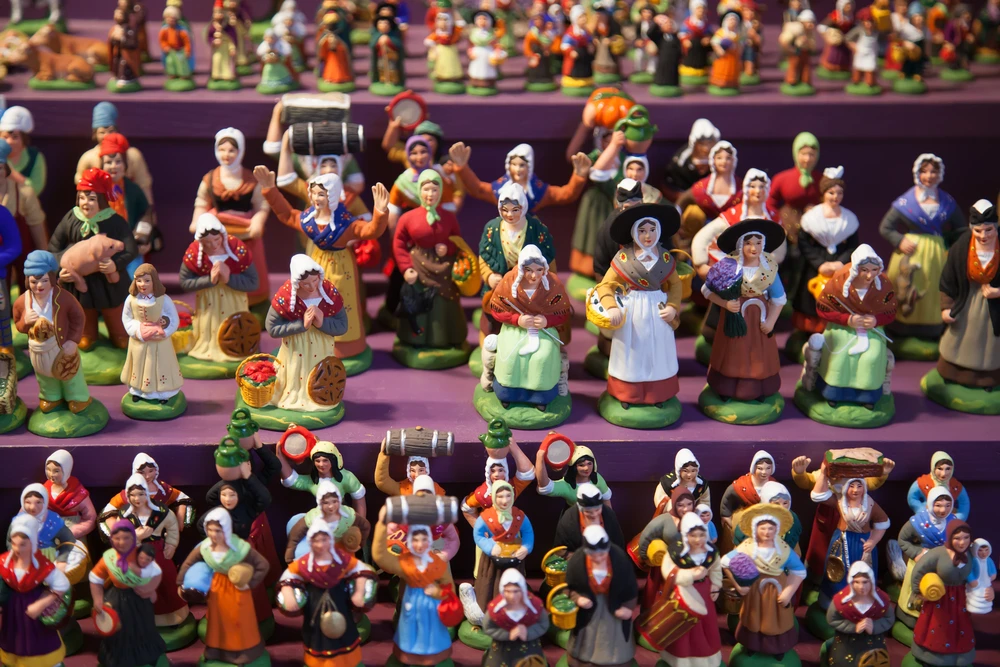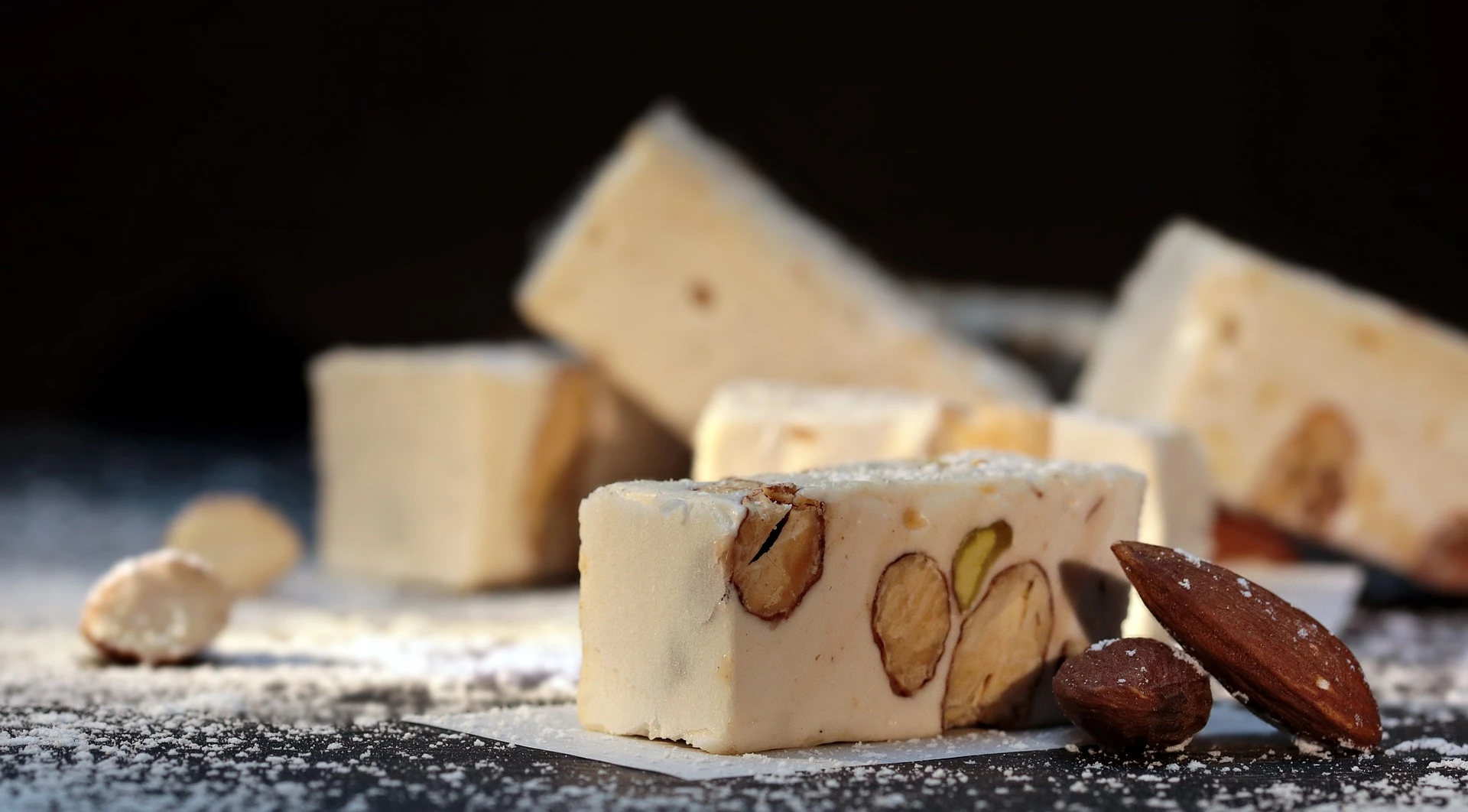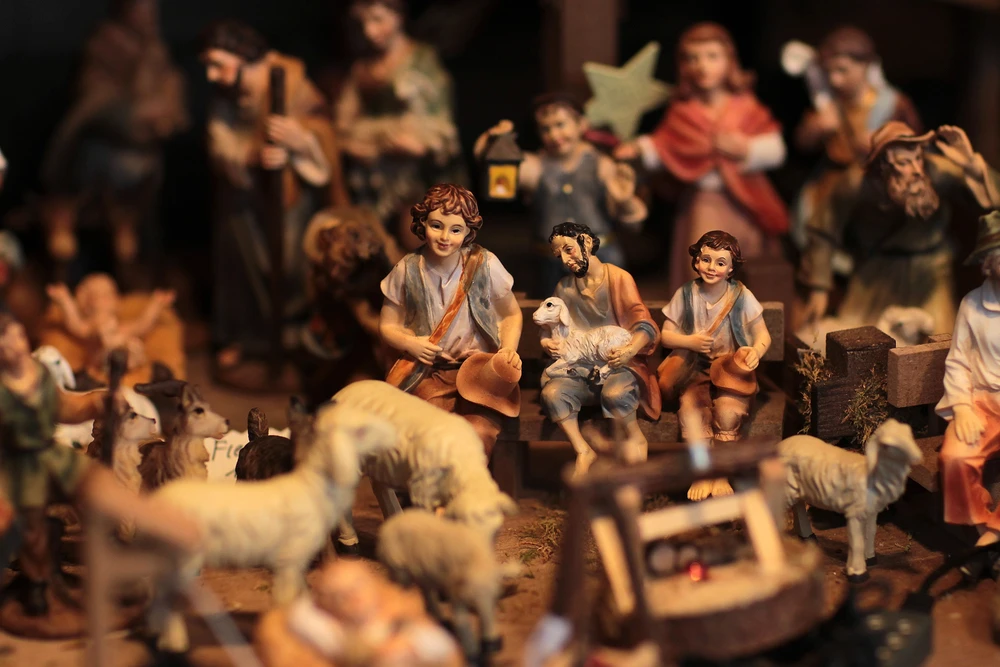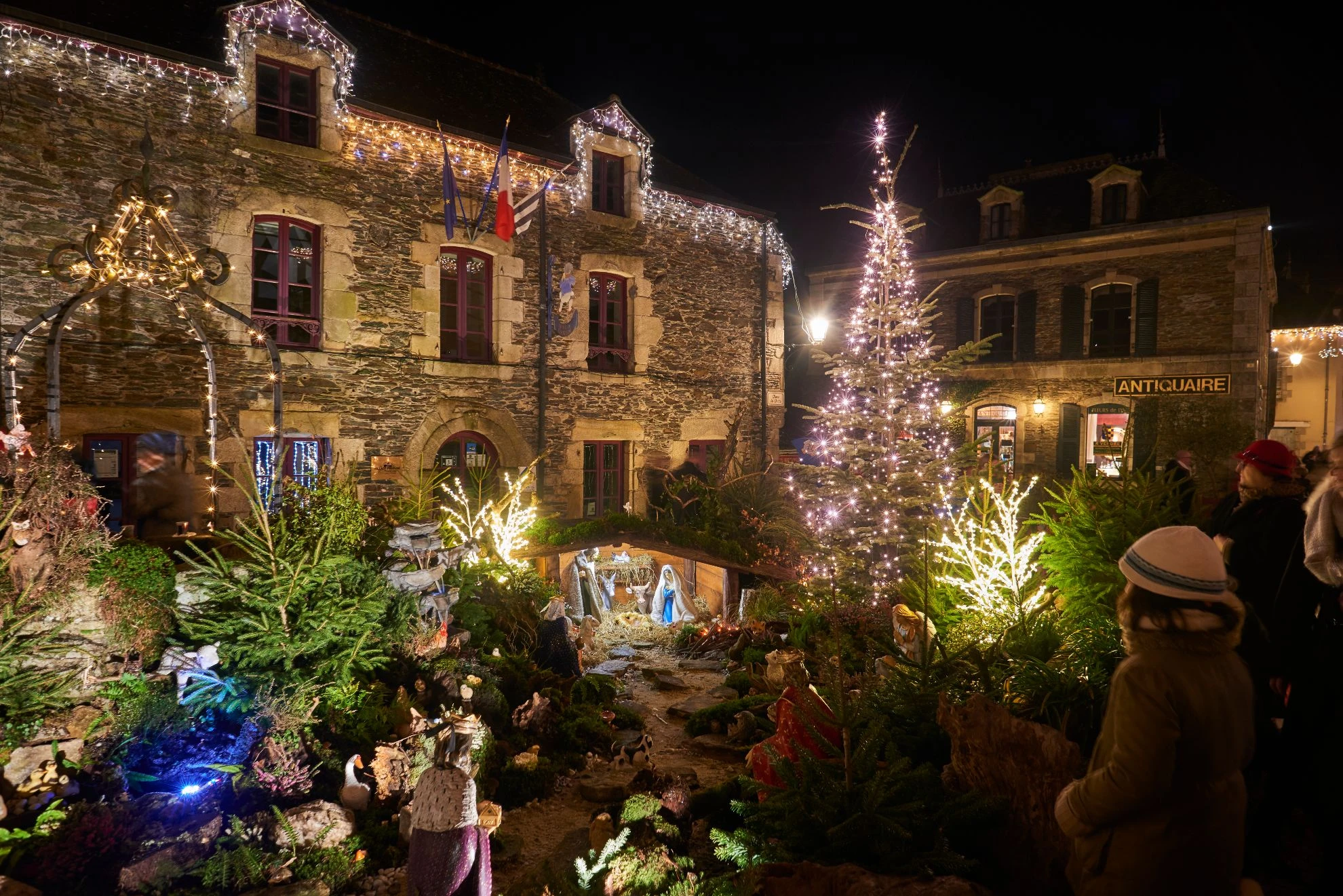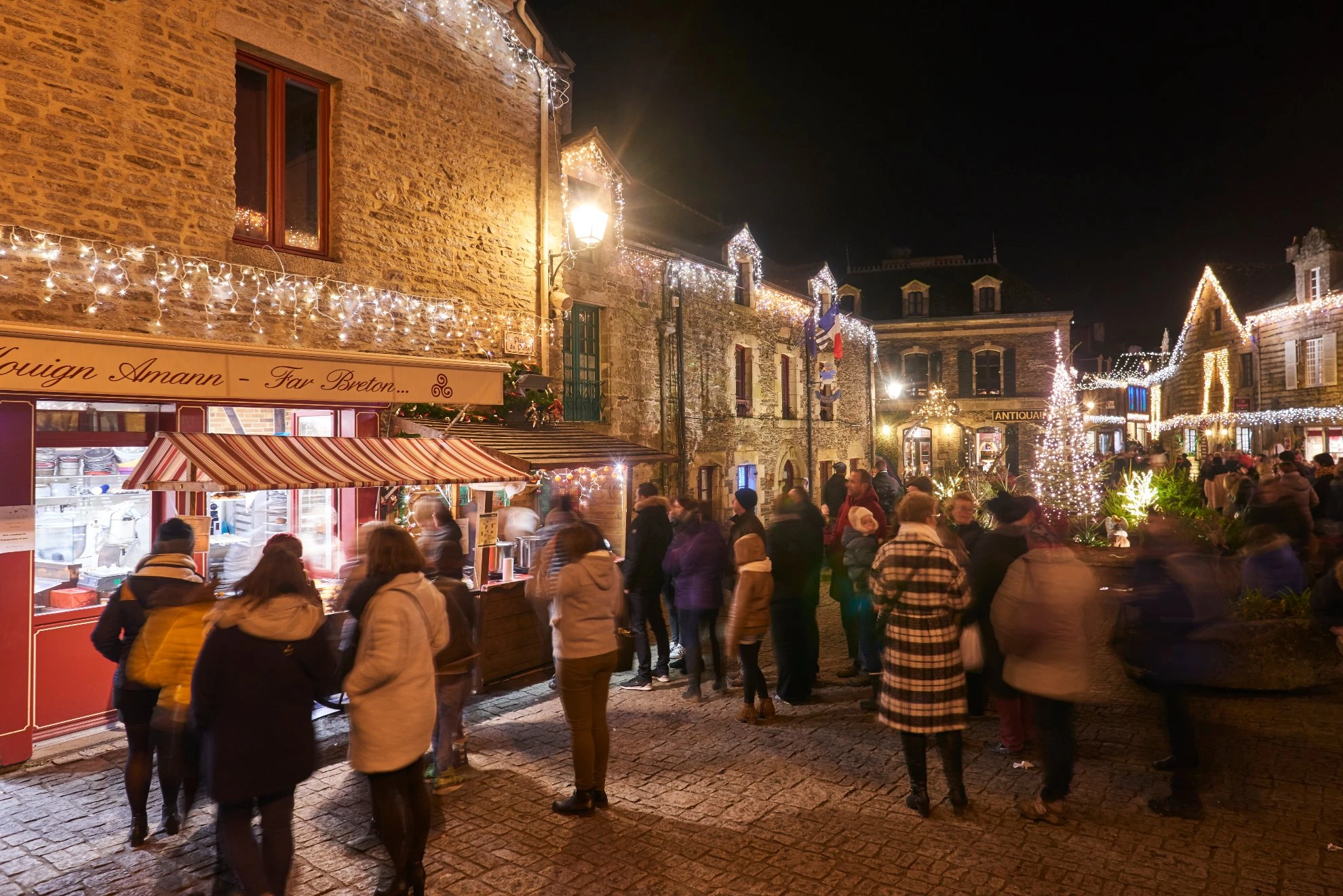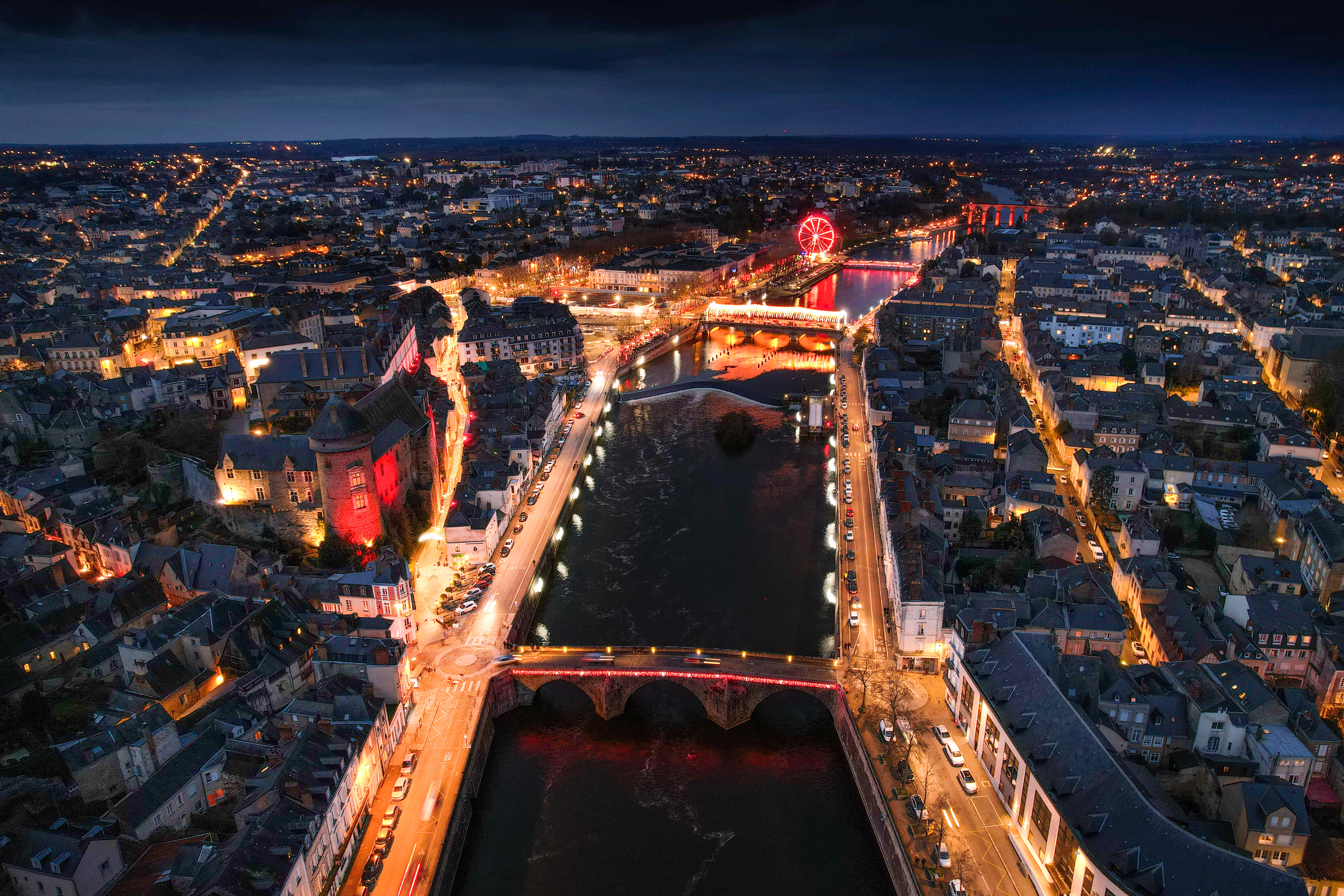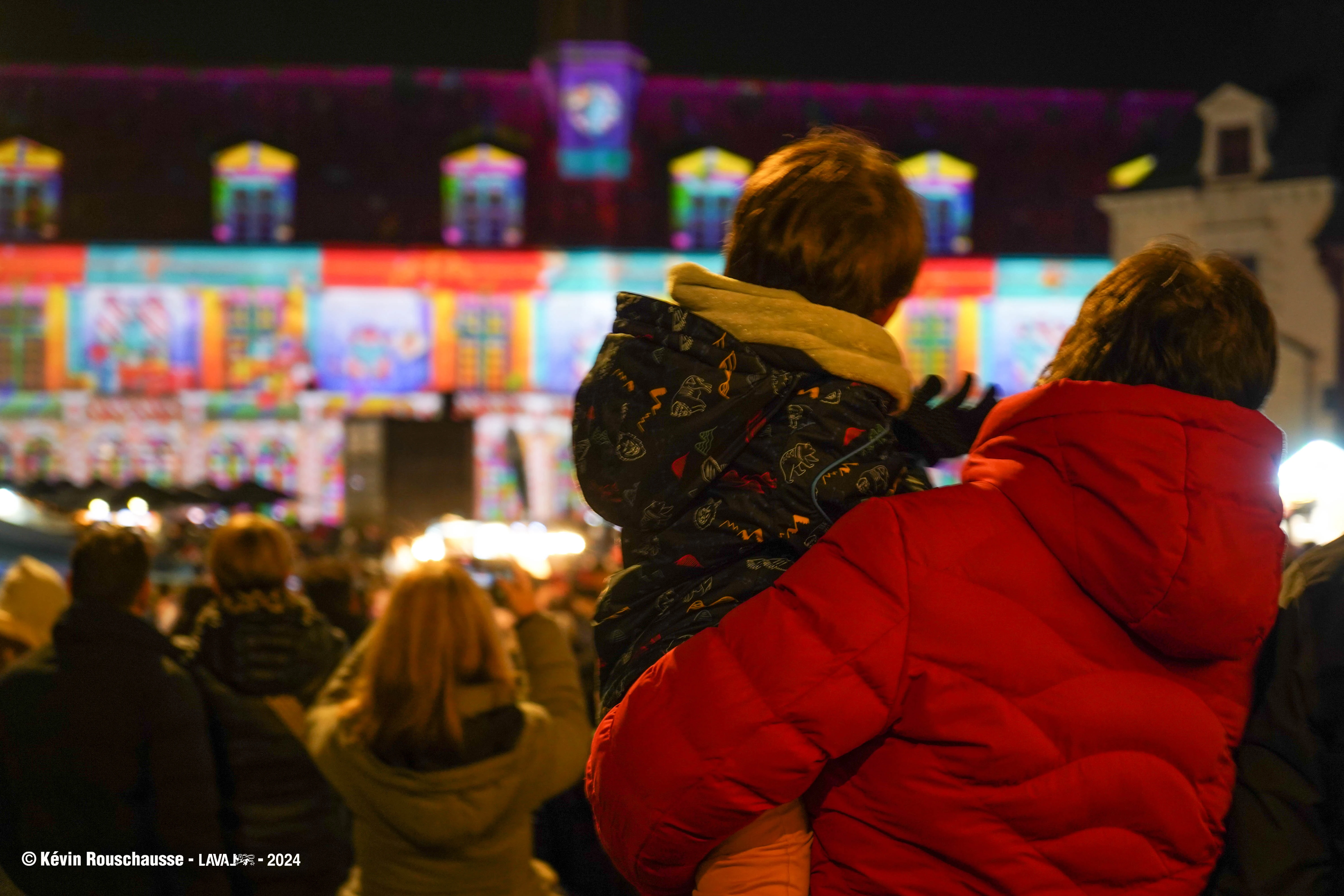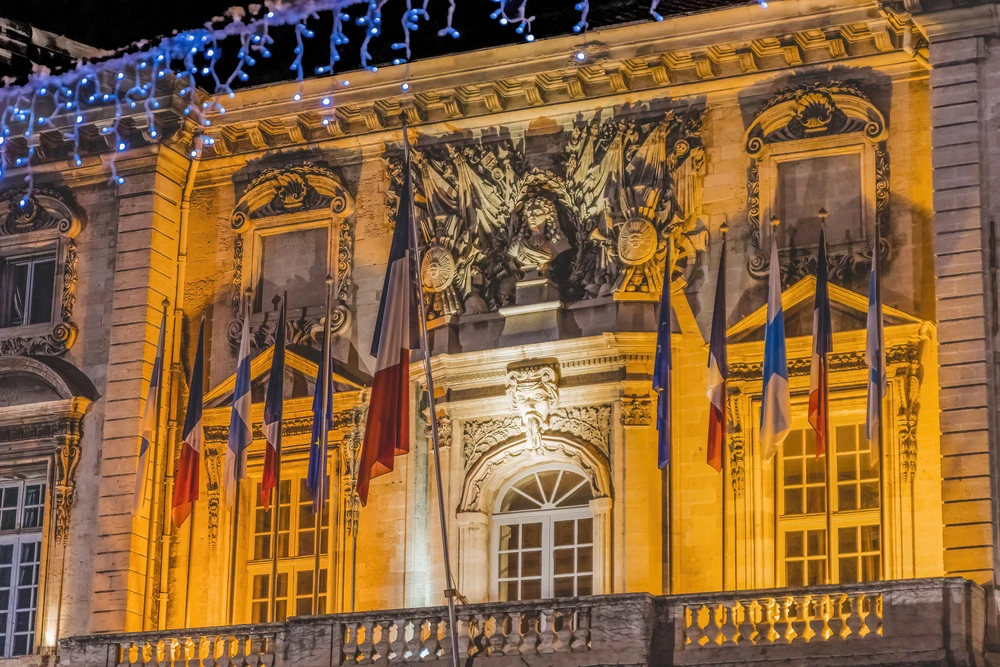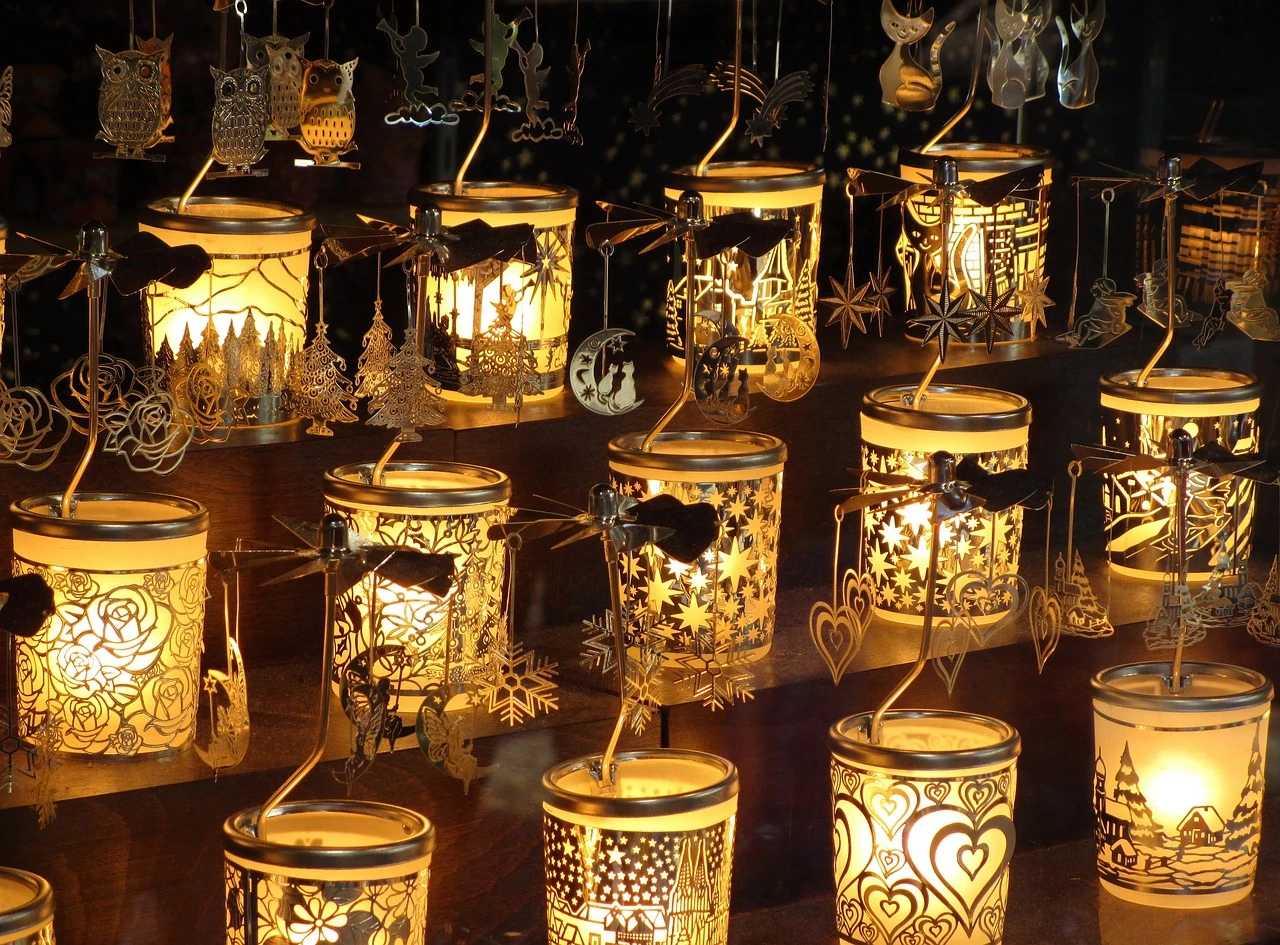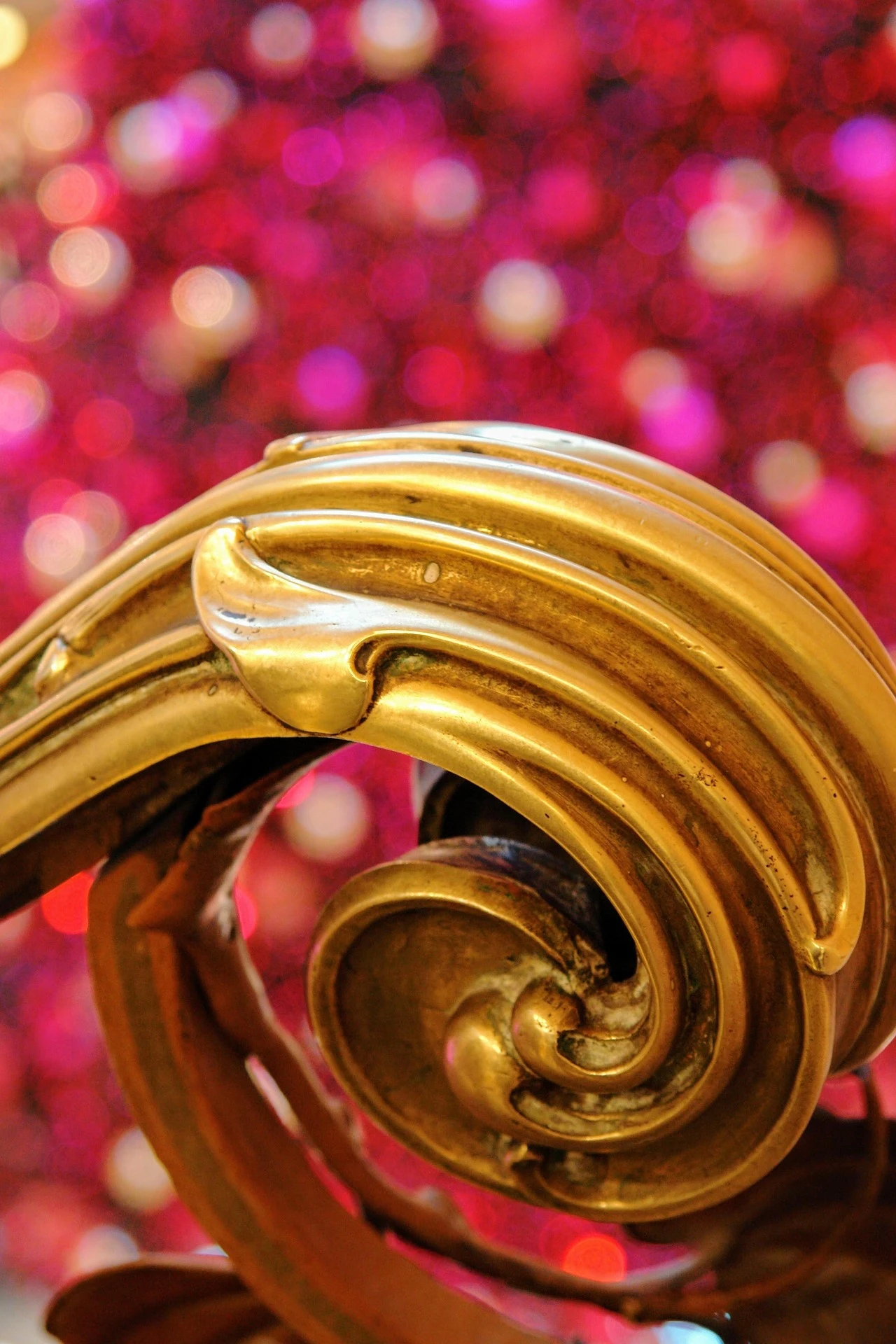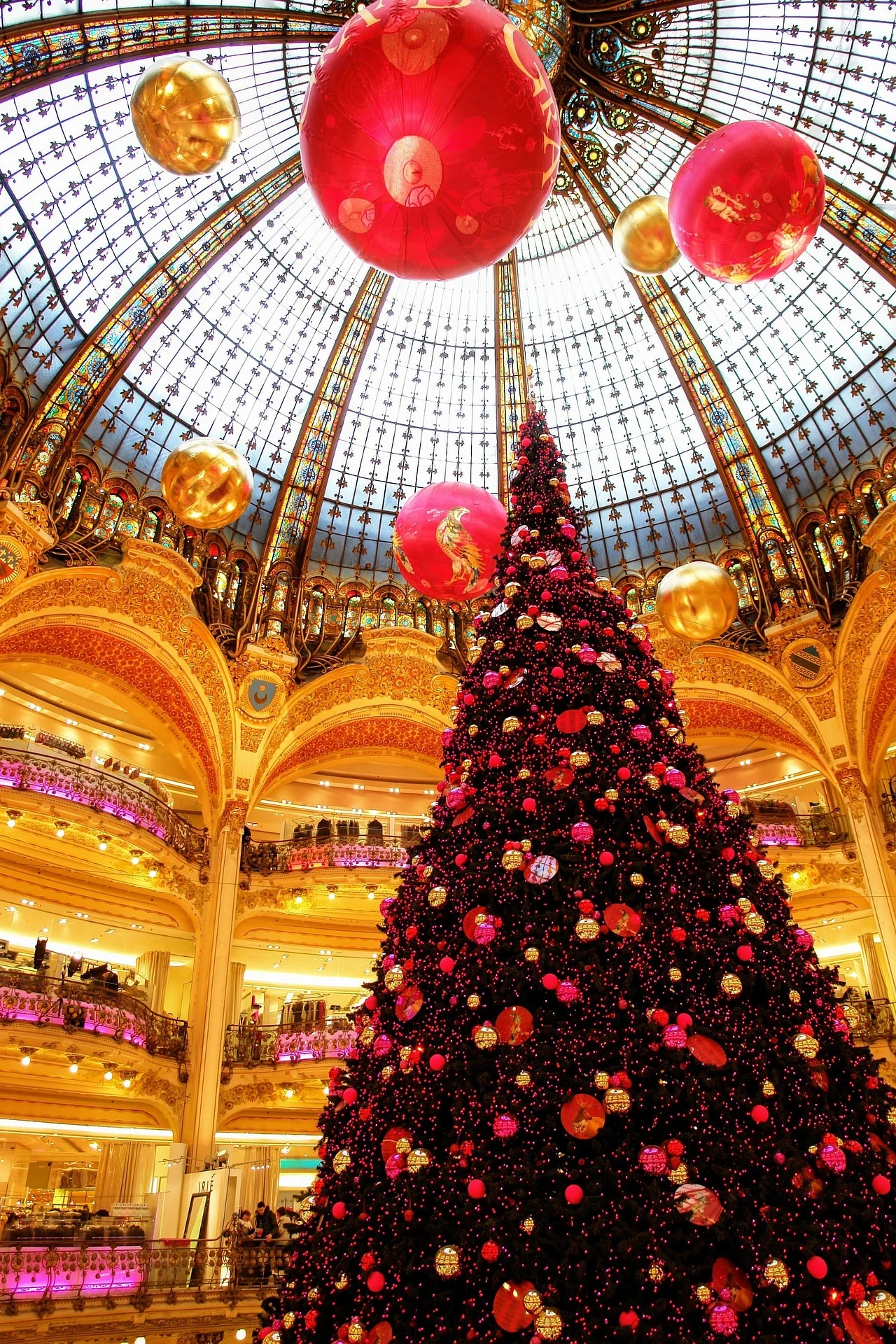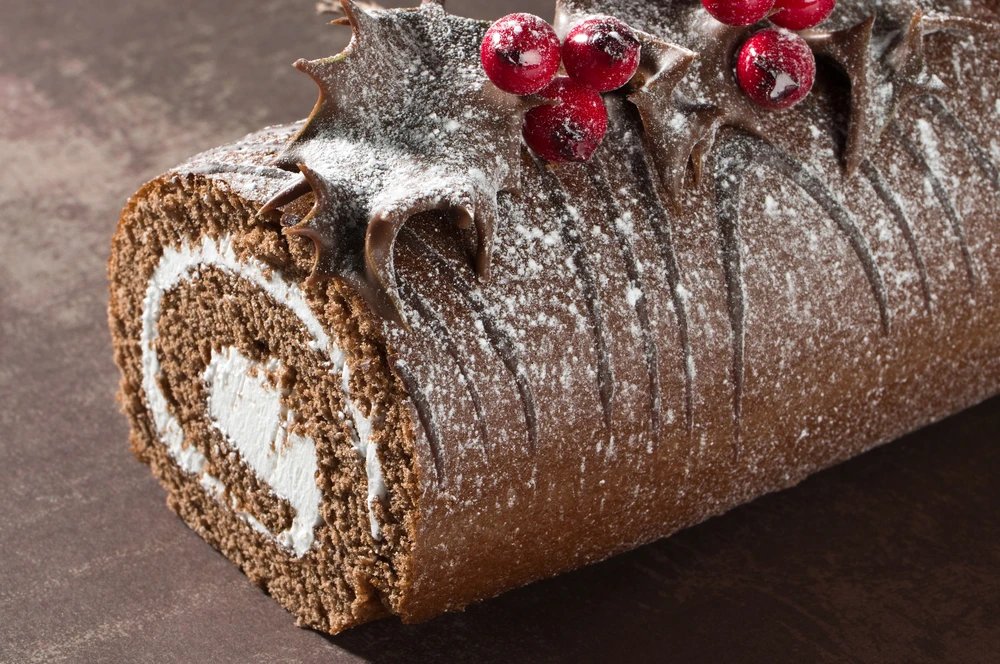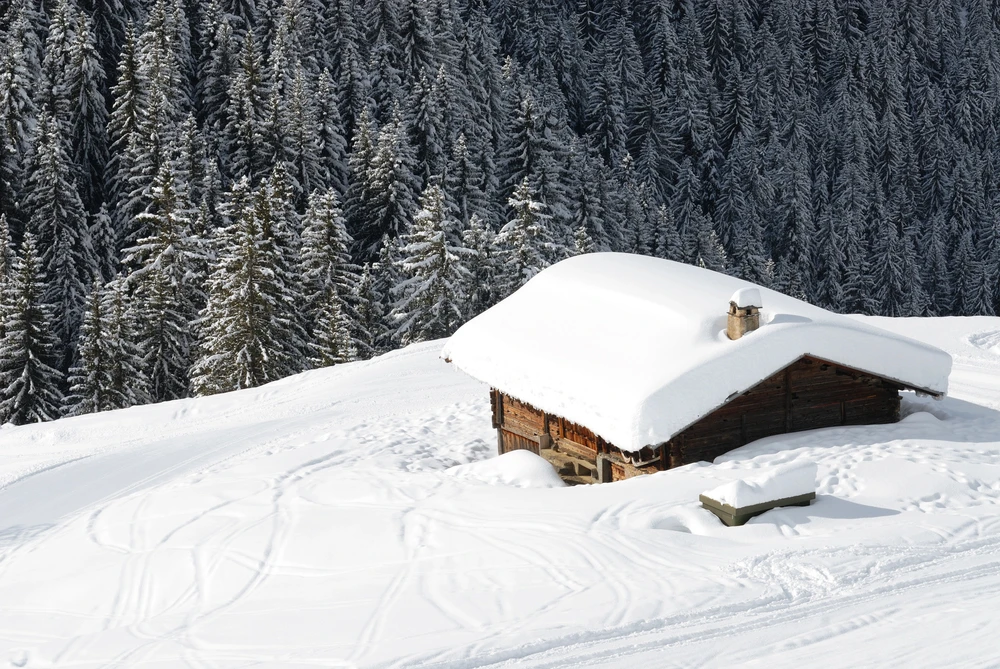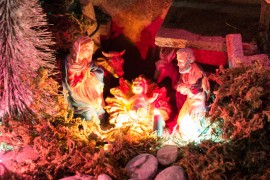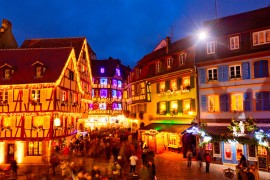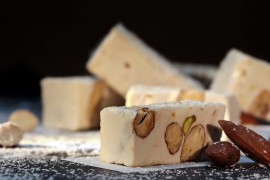Eastern France: the birthplace of true Christmas
View of the Christmas market in Riquewihr / Photo selected by monsieurdefrance.com: Xantana via depositphotos.com
It is in the east that the heart of French Christmas beats. From Champagne to Alsace, every town and village is decked out with garlands, the scent of spices, and the sound of choirs. You can smell cinnamon, mulled wine, and feel the crisp cold that colors your cheeks. Half-timbered facades, lively squares, and the enthusiasm of the locals make this region the most beautiful winter wonderland.
Strasbourg: the capital of French Christmas
The famous Grand Sapin tree on Place Kléber (it always comes from the nearby Vosges mountains). Photo selected by monsieurdefrance.com: ifeelstock via depositphotos.com
Since 1570, Strasbourg has been lighting up the magic of Europe's oldest Christmas market. Under the spire of the cathedral, Place Kléber is illuminated by a huge Christmas tree, while Petite France sparkles with golden reflections. In the evening, bells ring out and the air is filled with the scent of cinnamon.
What I liked best: watching the snow fall on the cobblestones of Petite France while the cathedral bells mingled with the laughter of passersby.
To taste: bredele, manalas, and mulled wine made with Gewurztraminer wine.
Where to stay: around Petite France, to enjoy the illuminated streets and canals.
Train station: Strasbourg-TGV (1 hr 50 mins from Paris).
Airport: Strasbourg-Entzheim (12 km, 20 mins).
Distance from Paris: 490 km – 5 hrs by car / 1 hr 50 mins by train.
Discover my program for visiting the Alsatian Christmas markets in one weekend.
Colmar: magic on the water
View of the Colmar Christmas market / Photo selected by monsieurdefrance.com: Xantana via depositphotos.com
In Colmar, Christmas is reflected in the canals of Little Venice. Chalets line the pastel-colored streets, garlands are reflected in the water, and candles light up the shop windows. The air smells of gingerbread and caramelized sugar.
What I liked best: walking along the canals at dusk when the reflections of the houses mingle with the lanterns.
To taste: kougelhopf, bredeles, Alsace white wine, and gingerbread with honey.
Where to stay: in the historic center, near Rue des Marchands.
Train station: Colmar-TGV (2 hours 30 minutes from Paris).
Airport: Basel-Mulhouse (58 km, 45 min).
Distance from Paris: 505 km – 5.5 hours by car / 2.5 hours by train.
Want to try Alsatian bredeles or make them yourself? Click here.
Kaysersberg, Riquewihr, Eguisheim: Alsatian jewelry
One of the streets in Kaysersberg at Christmas: Photo selected by monsieurdefrance.com: olesiabilkei via depositphotos.com
Nestled between the hills, Kaysersberg celebrates Christmas on a human scale. The ramparts are covered with garlands, the stained-glass windows light up at night, and artisans sell their wooden toys under the light snow. Not far away, and ranked among the most beautiful villages in France, Eguisheim revolves around its market as it would around a Christmas tree. The flower-covered facades are adorned with garlands in winter, and the aroma of mulled wine fills the narrow streets.
What I liked best: strolling around in the early morning when the alleys still smell of smoking logs and warm pastries.
View of the Christmas market in Riquewihr / Photo selected by monsieurdefrance.com: Xantana via depositphotos.com
To taste: tarte flambée, Christmas jams, and mulled wine with fir tree honey.
Where to stay: in the inns of the medieval center, between Rue du Général-de-Gaulle and the river.
Train station: Colmar (7.5 miles, 15 min).
Airport: Basel-Mulhouse (47 miles, 1 hr).
Distance from Paris: 317 miles – 3 hours 30 minutes by car / 2 hours 40 minutes by train via Colmar.
The top 7 Christmas markets in Alsace are here.
Metz: the most spectacular Christmas market in the city of lanterns
The magnificent Metz Cathedral shares the spotlight once a year with the illuminated Ferris wheel/ Photo chosen by Monsieur de France: (c) Inspire Metz
Beneath Saint-Étienne Cathedral and on Place de la République, chalets line up and the city lights up. It's a veritable spectacle of lights, colors, and flavors (this is Lorraine, after all, the home of food lovers). The Sentier des Lanternes (Lantern Trail) on the banks of the Moselle is enchanting, with hundreds of figurines, angels, and elves guiding visitors.
What I liked best: in the evening, when the Moselle is covered in golden and red reflections and you can hear the bells of the magnificent cathedral ringing above the lanterns.
The Metz market is probably the most spectacular in France / Photo chosen by Monsieur de France: (c) Inspire Metz.
To taste: smoked meats from Lorraine, wines from Moselle, macarons from Boulay, brioche from Metz, and mulled wine with citrus fruits.
Where to stay: in the old town, around Place Saint-Louis.
Train station: Metz-TGV (1 hour 25 minutes from Paris).
Airport: Luxembourg (60 km, 50 minutes).
Distance from Paris: 330 km – 3 hrs 30 mins by car / 1 hr 25 mins by train.
Discover the 7 wonders of Metz here
Place Saint Louis in Metz / Photo selected by Monsieur de France: (c) Inspire Metz.
Reims: bubbles and lights
Champagne! Photo selected by Monsieurdefrance.fr: KarepaStock/Shutterstock.fr
Beneath the vaults of Reims Cathedral, lights dance to the rhythm of colorful projections. The market, set up at the foot of the towers, combines crafts and champagne tastings. The streets echo with the clinking of glasses and the murmur of choirs.
My favorite part: sipping a glass of champagne while watching the Gothic facade light up with color.
Reims Cathedral / Photo selected by Monsieur de France: by Guy Dugas from Pixabay
What to try: pink cookies, marc shortbread, and a glass of champagne.
Where to stay: near Place d'Erlon or the Boulingrin neighborhood to enjoy the illuminations.
Train station: Reims-TGV (45 min from Paris).
Airport: Paris-Charles-de-Gaulle (130 km, 1 hr 30 min).
Distance from Paris: 145 km – 1 hour 45 minutes by car / 45 minutes by train.
Montbéliard: the theater of lights
Magnificent Montbéliard ! Photo chosen by Monsieur de France: © City of Montbéliard – Denis Bretey.
In the Doubs region, Montbéliard is covered with 100,000 light bulbs and smiles. The "Christmas Lights" illuminate every facade, while the chalets fill the air with the aroma of melted Comté cheese and mulled wine.
What I liked best: the frosty evenings when the square becomes a sky full of hanging stars.
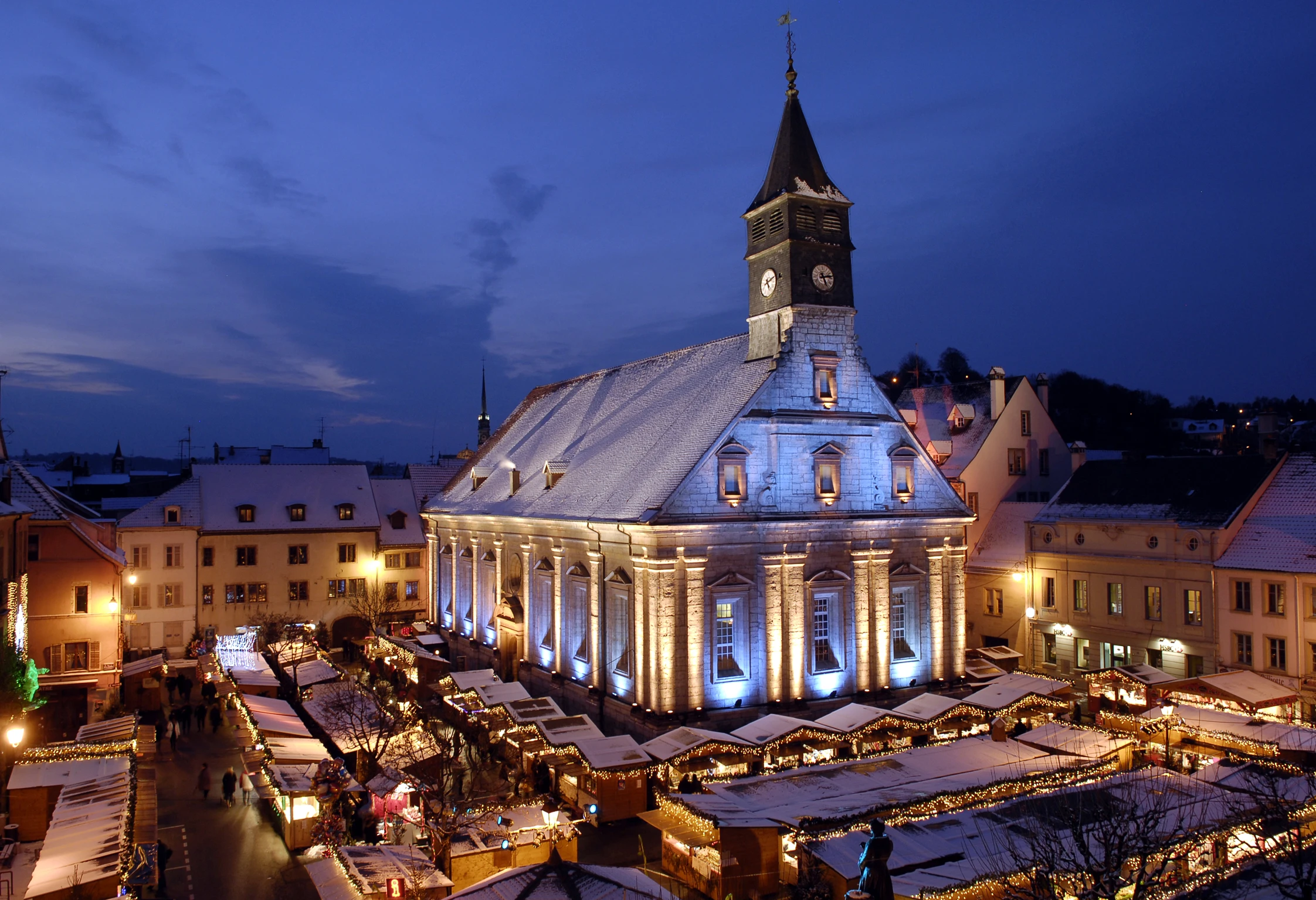
Around the Temple / Photo selected by Monsieur de France: : © City of Montbéliard – Denis Bretey.
To taste: cancoillotte cheese, gingerbread, and honey waffles.
Where to stay: near the Temple Saint-Martin, in the heart of the illuminations.
Train station: Montbéliard-TGV (2 hours 50 minutes from Paris).
Airport: Basel-Mulhouse (75 miles, 1 hour 20 minutes).
Distance from Paris: 270 miles – 4 hours 30 minutes by car / 2 hours 50 minutes by train.
Photo selected by Monsieur de France: : © City of Montbéliard – Denis Bretey.
Mountain lights: Christmas under the snow
In the Alps too, Christmas shines with pure brilliance. In Annecy, the market is set up between the lake and the mountains; the facades are reflected in the turquoise water and the cold air smells of vanilla and burning wood. In Chamonix, snow-covered fir trees surround the ice rink, and wooden chalets serve mulled wine and raclette by the light of oil lamps.
What I liked best: hearing the snow crunch underfoot and seeing the lights dancing on Lake Annecy.
Annecy in celebration / Photo selected by Monsieur de France: depositphotos
To try: tartiflette, fondue savoyarde, and hot chocolate with Chartreuse liqueur.
Where to stay: in Annecy in the Vieil-Annecy district, in Chamonix near Place Balmat.
Train station: Annecy-TGV (3 hours 40 minutes from Paris) / Chamonix-Mont-Blanc (5 hours from Paris).
Airport: Geneva-Cointrin (45 km from Annecy, 1 hour).
Distance from Paris: 550 km – 5 hours 30 minutes by car / 3 hours 40 minutes by train.
Fancy some delicious mountain cuisine? This way, please.
Paris: elegance and the magic of lights
by Peggy and Marco Lachmann-Anke de Pixabay
At Christmas, Paris sparkles like a crown of light. The Champs-Élysées, Place Vendôme, Faubourg Saint-Honoré, and the Eiffel Tower are decked out in gold. The air smells of roasted chestnuts, the shop windows buzz with music, and the Seine reflects the hanging garlands. It is especially around the department stores—Galeries Lafayette, Printemps Haussmann, and Le Bon Marché—that the magic becomes a spectacle: automatons, mechanical polar bears, and giant Christmas trees hang from the glass roofs.
The Tuileries Christmas market features chalets, an ice rink, and the smell of mulled wine; the Place de l'Hôtel-de-Ville hosts a Ferris wheel and a forest of Christmas trees.
What I liked best: standing there for a few minutes, my hands wrapped around a hot drink, watching the lights of Galeries Lafayette reflected in the bus windows and the smiles of passersby.
The Champs-Elysées in Paris / Photo selected by Monsieur de France: depositphotos
To taste: chocolate crepes, roasted chestnuts, mulled wine with spices, and Parisian shortbread cookies.
Where to stay: around the Opéra-Haussmann for the magical window displays or the Marais for the decorated alleyways.
Train station: all Paris train stations (direct arrival from all over France).
Airport: Paris-Charles-de-Gaulle (30 km, 40 min) or Orly (20 km, 30 min).
Paris loves Christmas/ Photo chosen by Monsieur de France: by G.C. from Pixabay
Provence and the South: lights and live nativity scenes
In the South, Christmas is celebrated in the light of the winter sun. Villages are decorated with lanterns, churches open their doors to welcome animated nativity scenes, and markets fill with the scent of almonds and honey. Provence retains a warmth that the cold can never extinguish: terraces remain full, and santons smile beneath their straw hats.
Provençal nativity scene characters. Photo selected by monsieurdefrance.com: depositphotos
Marseille and Aix-en-Provence: the capitals of santons
In Marseille, the Santon Fair—founded in 1803—is the oldest in France. Artisans display their clay figurines: shepherds, bakers, washerwomen, and angels with gentle faces. In Aix-en-Provence, the Santonniers Fair brings together the best craftsmen in the South. Every alleyway smells of candied orange and resin. On December evenings, the facades are lit up with a golden glow.
What I liked best: walking at dusk through the narrow streets of Aix, where you can hear the santonniers talking about their figurines, while the mistral wind carries the scent of nougat.
The famous white nougat. Photo selected by monsieurdefrance.com: Depositphotos
To taste: the thirteen desserts, calissons, Marseille navettes, and pompe à l'huile.
Where to stay: in Aix in the Mazarin district or on the Old Port in Marseille to enjoy the illuminated markets.
Train station: Aix-TGV (3 hours 5 minutes from Paris).
Airport: Marseille-Provence (25 km, 30 minutes).
Distance from Paris: 760 km – 7 hours 30 minutes by car / 3 hours 5 minutes by train.
Why not give it a try? The recipe for nougat is here.
Lucéram and the mountain nativity scenes
In the Alpes-Maritimes region, Lucéram is transformed into an open-air nativity scene: more than 400 scenes are scattered throughout the streets, on balconies, and even in fountains. In Arles, churches display huge monumental nativity scenes, and in Tarascon, the Christmas market is lit up with Provençal songs.
What I liked best: getting lost in the decorated streets of Lucéram and stumbling upon a tiny nativity scene in the hollow of an old stone wall.
Nativity scenes are a way of life in the South / Photo selected by Monsieur de France: depositphotos
To taste: sweet fougasse, white nougat, and mulled wine with thyme.
Where to stay: in Lucéram itself for the village atmosphere, or in Nice for easy access to the mountains.
Train station: Nice-Ville (5 hours 40 minutes from Paris).
Airport: Nice-Côte-d'Azur (40 km, 45 minutes).
Distance from Paris: 930 km – 8 hours 30 minutes by car / 5 hours 40 minutes by train.
Western France: enchantment and conviviality
In the West, Christmas takes on a gentle air. Stone facades are adorned with garlands, squares fill with music and laughter, and the reflections of the lights in the rivers create magical scenes. Here, the lights are those of sharing: simple, sincere, and full of warmth.
The Christmas Ferris wheel in Lavall / Photo (c) François Parmentier with permission from Laval Tourism.
Rochefort-en-Terre: a Breton gem beneath the garlands
In the heart of Morbihan, in Brittany, Rochefort-en-Terre sparkles every winter. The locals decorate every window and balcony, and the cobbled streets and granite houses are bathed in golden light. The craft market smells of warm crêpes, honey, and cider.
Rochefort en Terre illuminated / Photo (c) Rudy Burbant / Rochefort en Terre Tourist Office.
What I liked best: the glow of lanterns on wet granite, Breton songs drifting up from the alleyways, and the unforgettable smell of cider and burning wood. The best time to visit is at the end of the day during the week.
Things to try: Breton galettes, kouign-amann, hot cider, and salted butter caramel.
Where to stay: in guesthouses in the historic center or on Place du Puits, in the heart of the lights.
Train station: Questembert (9.3 miles, 15 min).
Airport: Nantes-Atlantique (68 miles, 1 hr 20 min).
Distance from Paris: 460 km – 4 hrs 45 mins by car / 3 hrs 15 mins by train via Questembert.
Rochefort en Terre illuminated / Photo (c) Rudy Burbant / Rochefort en Terre Tourist Office.
Laval: reflections of light on the Mayenne River
The bridge over the Mayenne River is magnificent / Photo (c) François Parmentier with permission from Laval Tourisme.
Every winter, Laval becomes a tale of water and light. The Illuminations de Laval, known throughout France, transform the banks of the Mayenne River into a colorful mirror. The medieval castle, bridges, and facades are adorned with changing reflections; the market stretches along the river, mixing mulled wine, music, and children's laughter.
What I liked best: the light from the bridges dancing on the dark water and the sweet smell of warm waffles on the quays.
Laval lights up! Photo (c) François Parmentier with permission from Laval Tourisme.
To taste: Laval shortbread cookies, mulled wine with cinnamon, and flambéed crêpes.
Where to stay: near the old castle or in the Quais district to admire the lights on the water.
Train station: Laval-TGV (1 hour 15 minutes from Paris). Airport: Rennes-Bretagne (80 km, 1 hour). Distance from Paris: 285 km – 3 hours by car / 1 hour 15 minutes by train.
Laval at Christmas is magical / Photo (c) Kevin Rouchausse with permission from Laval Tourisme.
Why not discover Mayenne? What a beautiful department to spend your vacation in the heart of France!
Other villages in the West to discover
In the Perche region, in Nogent-le-Rotrou, the medieval streets are lit by lanterns. In Normandy, Bayeux illuminates its cathedral and half-timbered houses with a golden glow. In the Vendée, Fontenay-le-Comte offers an intimate market where artisans carve wood and leather. To taste in the West: Cancale oysters, galettes saucisses, Anjou wines, and Normandy shortbread.
All over France, magic shines close to home
Marseille illuminated / Photo selected by Monsieur de France: depositphotos
You don't always have to travel far to feel the magic of Christmas. Across the country, villages and small towns compete to be the most imaginative, with garlands strung between houses, Christmas trees decorated by children, and nativity scenes set up in town squares. In Lorraine, Burgundy, the Alps, and Gascony, every bell tower becomes a beacon in the night. Even without a large market, there is always a corner of France near your home that lights up and inspires dreams.
Christmas markets are also a great place to find decorations for the holidays. Photo selected by monsieurdefrance.com: by moni quayle from Pixabay
Conclusion: France, land of light
From Strasbourg to Laval, from Paris to Rochefort-en-Terre, every winter France proves that Christmas is a shared emotion.
These lights and markets reflect a very French way of life: bringing people together, inspiring wonder, and passing on traditions.
No matter where you are in the country, just look up to see the magic happen.
In France, Christmas isn't just a holiday: it's a light.
FAQ – Christmas in France for foreign visitors
When does the Christmas season start in France?
The festivities begin at the end of November with the first Christmas lights and the opening of the Christmas markets, especially in Alsace and Paris. The season ends with Epiphany on January 6, when the French share the galette des rois (king cake).
Which Christmas markets are not to be missed?
The most famous are those in Strasbourg, Colmar and Kaysersberg in Alsace. But there are also superb markets in Metz, Reims, Paris, Annecy, Lille, and Montbéliard. Each has its own atmosphere, specialties, and lights.
The Galeries Lafayette Christmas tree changes every year. Image selected by Monsieur de France: by Peggy and Marco Lachmann-Anke from Pixabay
Where can you see the most beautiful Christmas lights?
France shines brightly at Christmas!
-
In Paris, the Champs-Élysées, Place Vendôme, and Galeries Lafayette sparkle every evening.
-
In Alsace, villages such as Colmar, Eguisheim, Obernai, and Ribeauvillé are illuminated in a magical atmosphere between half-timbered houses and the smell of mulled wine.
-
In Rochefort-en-Terre (Brittany), voted "France's favorite village" several times, the entire town is decked out in enchanting light displays.
-
In Laval or Montbéliard, rivers and monuments are reflected in the light, creating veritable living paintings.
-
Disneyland Resort Paris is also pulling out all the stops to offer a breathtaking Christmas season.
How do the French celebrate Christmas?
On the evening of December 24, families share a big dinner: oysters, foie gras, poultry, cheese, and Yule log. December 25 is a day of rest and reunion. In the northeast, in Lorraine, Saint Nicholas is celebrated on December 6 with treats for children.
What traditional dishes should you try during the holidays?
Foie gras, stuffed turkey, boudin blanc, scallops, Alsatian bredeles, chocolate truffles, ice cream logs, and gingerbread. Christmas markets also offer mulled wine, waffles and crepes to enjoy on site.
The traditional Yule log with chocolate buttercream. Photo selected by monsieurdefrance.com: depositphotos.
What is the weather like in December?
Cool, but rarely freezing. On average, 5°C in Paris, 0°C in Alsace, and 10 to 15°C on the French Riviera. Snow is common in the east and in the mountains, but rarer elsewhere.
Christmas in the snowy mountains—isn't that something we all dream of? Photo selected by monsieurdefrance.com: ventdusud via depositphotos
Is it necessary to book in advance?
Yes! Hotels and trains fill up quickly in Strasbourg, Colmar, Paris, and Lyon. Remember to book at least three to four weeks before Christmas to get the best deals.
Why visit France at Christmas?
Because in December, France transforms into a luminous fairy tale.
Between traditions, gastronomy, and craftsmanship, each region tells its own story.
It's one of the best times of the year to discover French culture through its flavors, markets, and lights.
<time datetime="November 1, 2025">Updated: November 2025</time>
<time datetime="November 1, 2025">Updated: November 2025</time>

